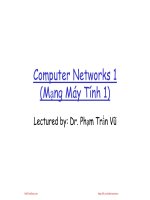mạng máy tính phạm trần vũ bài giảng 7 network layer in the internet
Bạn đang xem bản rút gọn của tài liệu. Xem và tải ngay bản đầy đủ của tài liệu tại đây (2.14 MB, 31 trang )
Computer Networks 1
(Mạng Máy Tính 1)
Lectured by: Dr. Phạm Trần Vũ
1
SinhVienZone.com
/>
Lecture 7: Network Layer in the
Internet
Reference:
Chapter 5 - “Computer Networks”,
Andrew S. Tanenbaum, 4th Edition, Prentice Hall, 2003.
2
SinhVienZone.com
/>
The Network Layer in the Internet
•
The IP Protocol
•
IP Addresses
•
Internet Control Protocols
•
OSPF – The Interior Gateway Routing Protocol
•
BGP – The Exterior Gateway Routing Protocol
•
IPv6
3
SinhVienZone.com
/>
Design Principles for Internet
•
•
•
•
•
•
• Look for a good
Make sure it works.
design; it need not be
Keep it simple.
perfect.
Make clear choices.
• Be strict when
Exploit modularity.
sending and tolerant
when receiving.
Expect heterogeneity.
• Think about
Avoid static options
scalability.
and parameters.
• Consider performance
and cost.
4
SinhVienZone.com
/>
Collection of Subnetworks
The Internet is an interconnected collection of many
5
networks.
SinhVienZone.com
/>
The IP Protocol
The IPv4 (Internet Protocol) header.
6
SinhVienZone.com
/>
The IP Header
Version: version of the protocol used
IHL: header length (number of 32-bit words)
Type of service: combination of reliability and speed, commonly
ignored by routers
Total length: length of the datagram
Identification: to identify a fragment within a datagram
DF: don’t fragment, tell the routers not to fragment
MF: more fragments
Time-to-live: a time counter to limit the message lifetime
Header checksum: of the header only
Source and destination addresses: address of the source and
destination of the datagram
7
SinhVienZone.com
/>
IP Options
Some of the IP options.
8
SinhVienZone.com
/>
IP Addresses
IP address formats.
9
SinhVienZone.com
/>
IP Address Classes
Class A: 128 networks, 16 mil hosts each
Class B: 16.384 networks, 64K hosts each
Class C: 2 mil networks, 256 hosts each
Class D: for multicast
Class E: Reserved
10
SinhVienZone.com
/>
IP Addresses (2)
Special IP addresses.
11
SinhVienZone.com
/>
Subnets
A campus network consisting of LANs for
various departments.
12
SinhVienZone.com
/>
Subnet and Subnet Mask
•
Some bits of the host are used to create subnet
number
•
Subnet masks are used to indicate the splits
between network, subnet number and host number
A class B network subnetted into 64 subnets (6 bits).
13
SinhVienZone.com
/>
Routing with Subnetting
Routing to destination to an outside network
is done as usual
Routing table adds more entries for routing
within the network
(this-network, subnet, 0): to route message to
another subnet
(this-network, this-subnet, host): to route
message to a host within this-subnet
14
SinhVienZone.com
/>
CDR – Classless InterDomain
Routing
•
Allocate IP addresses in variable size block without
regard to classes
•
If a site needs, it is provided with a block of
addresses
•
Routing process is more complicated
A set of IP address assignments.
15
SinhVienZone.com
/>
NAT – Network Address
Translation
Placement and operation of a NAT box.
16
SinhVienZone.com
/>
NAT – Network Address Translation
(2)
Use TCP or UDP header (source port field) of a
message to keep track of its outgoing
connection
A mapping table is used at the NAT box to
keep track of the private IP + port the NAT
index
In coming message address is reversed back
to original private IP and source port using the
index
17
SinhVienZone.com
/>
Internet Control Message Protocol
•
Used when unexpected events occurred in the
network, also used to test the network
The principal ICMP message types.
18
SinhVienZone.com
/>
ARP– The Address Resolution
Protocol
•
Used to map an IP addresses to data link layer
addresses, e.g. Ethernet addresses
Three interconnected /24 networks: two Ethernets and
an FDDI ring.
19
SinhVienZone.com
/>
Dynamic Host Configuration
Protocol – DHCP
•
A replacement for RARP (Reverse ARP)
and BOOTP (Bootstrap protocol)
Operation of DHCP.
20
SinhVienZone.com
/>
OSPF – Open Shortest Path First
The Interior Gateway Routing Protocol
To replace RIP (distance vector protocol) when the
networks getting bigger
Similar to Link State Routing Protocol
Requirements:
Open
Support variety of distance metrics
Dynamic
Support service based routing
Do load balancing
Support hierarchical systems
Security
SinhVienZone.com
/>
21
OSPF (1)
(a) An autonomous system. (b) A graph representation of
(a).
22
SinhVienZone.com
/>
OSPF (2)
The relation between ASes, backbones, and areas in
OSPF.
23
SinhVienZone.com
/>
OSPF (3)
The five types of OSPF messages.
24
SinhVienZone.com
/>
BGP – Border Gateway Protocol
The Exterior Gateway Routing Protocol
For routing messages between Autonomous
Systems
Often constrained by:
Politics
Security
Economic considerations
Routers are configured with policies
25
SinhVienZone.com
/>









